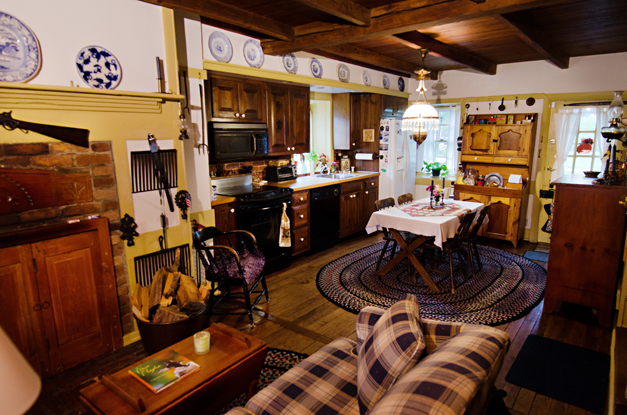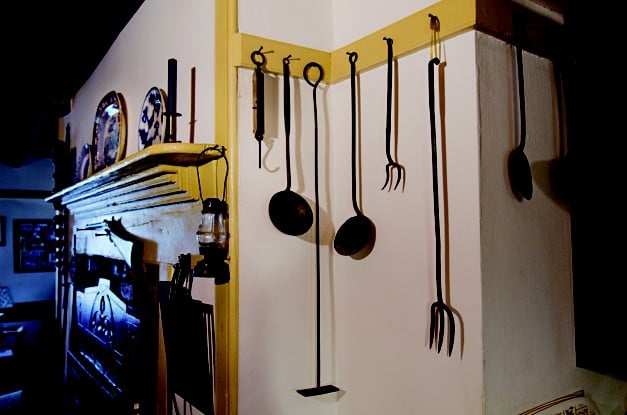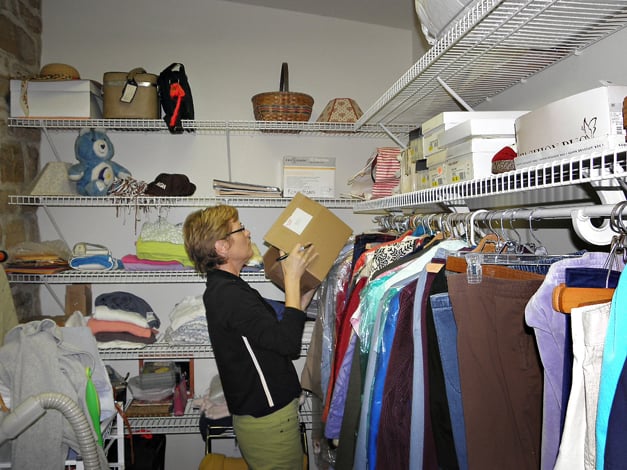Another year has gone by, and with its passing we are left with the memories of our past. We are also left with the stuff we bought the year before, and the year before that.
Traditionally, our memories start fresh with a champagne toast on New Year’s Eve at the stroke of midnight. We raise our glasses and sing a verse or two of Auld Lang Syne, in honor of our beloved friends. Some of us even take home a shiny paper hat or noisemaker after the party for a keepsake.
But according to Vali G. Heist, certified professional organizer and owner of The Clutter Crew, that’s probably not a good idea because the novelty will only be in the way of more important things. At some point, it will eventually need to be stored, given away or discarded.

LET IT GO
Vali, in the business of de-cluttering other’s homes for six years now, has been organizing her own home for 28 years. She employs the “one in-one out” rule (meaning if you buy something, you get rid of something else) to manage her things. Her husband of 36 years, Robert “Bob” M. Heist, a retired teacher, is the exact opposite of his wife.
The couple resides in Mohnton in a three-bedroom farmhouse with small rooms. “We don’t have the space, so if it’s not out, and I’m not enjoying it, I don’t get why I’m keeping it,” she says. Bob, on the other hand, doesn’t agree. “He is sentimental about his stuff; he has to see it and he is fine with the way it lies around,” Vali says.
GETTING STARTED
It takes close to an hour for Vali to address her client’s needs during an in-home assessment (cost: $25); she also discusses their timeframe or deadline and how they feel about getting rid of clutter. If Vali is hired for the project (cost: $65/hour) she and her client work one-on-one, handling every item with consideration and care. She starts the process by asking questions like “Why do you have that?” “What do you use this for?” or “How long have you had that?” Something you will never hear her say is “You don’t need that.”
A client always has final say on whether their unwanted or unused item is donated, sold, recycled or thrown away. If an item is “eBay-worthy” Vali will store it (for six months) and list it on consignment at stores.ebay.com/The-Clutter-Crew-Closet.
ORGANIZE THIS
If there is a room in your home that has become the catchall place for your “stuff,” now is a good time to purge and organize it. Just relax, take a deep breath, and be ready to let go of a few things.
Step one is to take out anything you don’t want to keep, suggests Vali, who has a realistic approach to clutter.
With Vali’s help, client Betty Gerlach of Topton organized her large walk-in bedroom closet in less than two hours. The wardrobe, with its many wall shelves, was designed to store more than just clothing and shoes for one person. Unfortunately, it had become the perfect space for Betty to put things that she no longer needed or used.
They began to de-clutter the room by looking at clothing that Betty might want to donate or resell. “How about that?” says Vali, holding up a dress. “Do you want to let that one go?”
“No, I’ll keep that,” replies Betty, who was not ready to let go of her dresses from the past.
Vali holds up another dress for inspection. “And, I’ll keep that one,” Betty says. “They are the only dresses I have; it’s a good idea to keep them.”
Sensing her client’s hesitation to purge the garments, Vali advises Betty to just use her best judgment. “You know if you’re going to wear it,” she says, taking another dress off the rack.
“How about letting go of this one?” she asks. “That was a good dress,” Betty replies.
“Do you think you could choose between these two?” coaxes Vali, who is holding up both dresses now.
“I could do that,” says Betty, who is starting to warm up to the idea of letting go.
Before they try to purge more items, Vali suggests to Betty that she turn her clothes hangers one way so that she can keep better track of clothes she doesn’t wear.
“That way if you didn’t wear it, you know to get rid of it next year,” Vali says as the two women start weeding out shoes, purses and other stuff.

“I still think we’ve done something good,” says Betty about letting go of her dress. “Every little bit helps, Betty,” Vali says, encouragingly.
Next, Vali takes a purse off the shelf and inspects it. “That’s a good purse,” Betty says. “They’re all good,” says Vali, smiling. “It’s whether you use them or not; that’s the big thing.”
By the time the project is finished, Betty has purged dresses, shoes, purses, empty boxes, hangers (for recycling), hats and other items to either donate or resell on eBay.
The things she wanted to keep were identified, labeled and organized by priority. For example, the lowest shelf on the immediate right side of the closet now contains Betty’s scrapbook supplies, including stationery, cards, letters, pictures, newspaper clippings and other important papers.
On the left side of the closet, Vali organized Betty’s toiletries and cleaning products by containing them in wicker baskets and plastic bins.
“I think we did a huge job,” says Betty about her newly organized closet. “That looks much better, much better.”
But Betty’s story doesn’t end here.
HONOR YOUR THINGS
The definition of clutter is different for everyone. For example, clutter can be things that were given to you that you don’t like or need, unfinished projects or hobbies, poor buying decisions or memorabilia from the past that no longer has value, according to Vali’s organizing tips on the Web.
In Betty’s situation, she still had an emotional attachment to things she hadn’t worn or used in years, but with Vali’s encouragement, she was able to let them go.
Overall, Vali was quite pleased with how Betty handled clutter in addition to how she honored the things of value in her home. For instance, Betty, an avid scrapbooker, saved the most important documents in her life: pictures and cards and letters from family members and friends—memories saved and contained on the inside pages of her books.
Furthermore, over the years, Betty has mastered the art of honoring and displaying the things she loves in her large stone 1700s farmhouse. The 200-acre estate called Stony Brook Farm has been in the Gerlach family for 56 years. Its breathtaking view, including a large 1850 bank barn with original hex signs, a summer kitchen, a pond and a wishing well, greets Betty each morning outside her first-floor master bedroom window.
There isn’t an inch of space that doesn’t hold a special meaning or story waiting to be told. For instance, six engraved pewter mugs, displayed in the kitchen on a peg shelf on the wall above a jelly cupboard, represent family members’ alma maters: Lehigh University, Bethlehem; the former Sullins College, Bristol, VA; Princeton University, NJ; and Colgate University, Hamilton, NY.
In the living room, two teddy bears sit sid-by-side on a small antique wooden rocking chair that belonged to Betty’s husband, the late Earl “Cy” Gerlach, when he was a little boy. The bears, close to 100 years old, are remnants of Betty’s and Cy’s childhoods.
A white English Ironstone gravy boat, tea set with sugar and creamer, platters and covered vegetable tureens are displayed in the trough of a dry sink in the kitchen. The tableware belonged to Cy’s grandparents. Ironstone came to this country in the 1700s on ships sailing to America. “They used Ironstone as ballast on the inside edges of ships to keep them upright in storms,” Betty says. On top of the dry sink are six copper measures, from a gallon to a half-gill. The largest measures were purchased first and were gifts from Betty’s two daughters. Betty and Cy found three more measures – a quart, pint and half-gallon – in 1965 at an antique show. The half-gill was purchased from an antique dealer in Topton. “It probably cost more than all the others put together!” Betty shares.
Above the kitchen sink on a high ledge are 11 imported blue-and-white china plates, all with different scenes. Three more plates grace the mantel above the kitchen fireplace.
A grouping of original work by the late artist Marshall C. Hudson decorates two kitchen walls. “We met him on one of our many trips to Ireland,” says Betty, whose grandmother was a native of Wales, Great Britain.

A five-gallon copper kettle that was used many years ago to make apple butter is now used to store kindling and firewood in the kitchen. Another much larger copper kettle in the living room can hold enough firewood to feed all three working fireplaces in the home.
Remember, Vali says, if it isn’t useful, isn’t beautiful, or doesn’t bring you joy, it’s CRAP, a term she’s coined that means: “Clutter that Robs Anyone of Pleasure.”
Look for more helpful links and lots of free information, including organizing tips and ideas for reselling or donating your stuff, on Vali’s website at thecluttercrew.com.









































